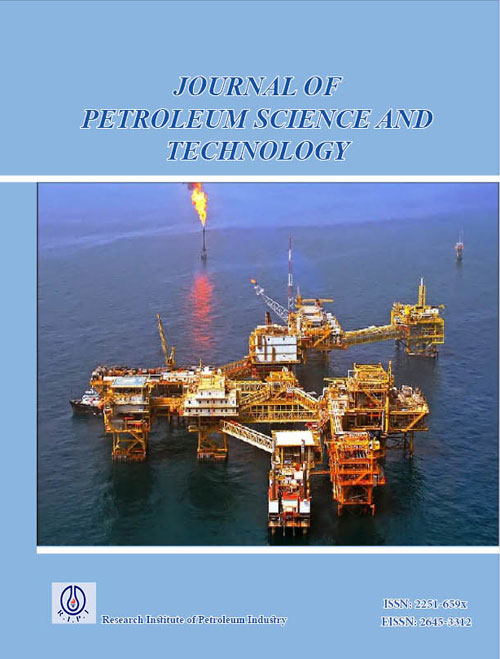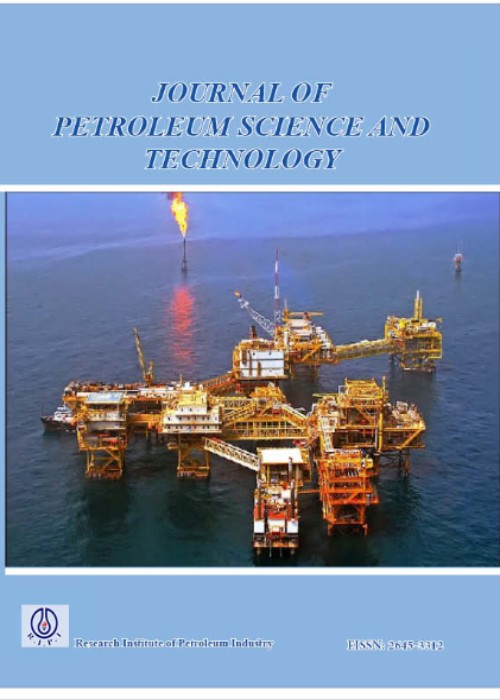فهرست مطالب

Journal of Petroleum Science and Technology
Volume:11 Issue: 4, Autumn 2021
- تاریخ انتشار: 1401/06/16
- تعداد عناوین: 6
-
-
Pages 2-13The liquid bridge is considered a good means to maintain capillary continuity between overlying matrix blocks if its stability in fractures is preserved. Despite several studies focusing on the liquid bridge in different environments, little attention is paid to dig through a single liquid bridge between thin sections of minerals found in fractured reservoirs. In this study, a set of experiments was conducted to investigate liquid bridge stability and surface profile for different values of liquid volume and surface wettability conditions. It is found that critical fracture aperture is linearly proportional to the contact angle and to the third root of liquid volume, which is depicted by a newly developed expression. An accurate method for computation of capillary pressure of liquid bridge (known as fracture capillary pressure) from the experimentally determined interface profiles, based on the numerical solution of the Young-Laplace equation, is proposed. Following the Plateau sequence, both nodoid and unduloid shape bridges are observed with an increase in fracture aperture, corresponding to positive and negative fracture capillary pressure, respectively. It is interesting to note that instability of liquid bridges occurs at small negative values of capillary force where some attraction force exists between fracture faces. By applying a 1D mathematical model of liquid dripping, a modified expression for the prediction of critical fracture aperture is proposed, including fluid and flow-related parameters. The findings of this study help to better incorporate the role of liquid bridge and corresponding fracture capillary pressure in capillary continuity in fractured porous media.Keywords: Liquid bridge, Capillary Bridge, Capillary continuity, Critical fracture aperture, Fracture capillary pressure, Experimental, Theoretical
-
Pages 14-23Various organic fuels, including citric acid, ethylene glycol, glycine and urea, were used to synthesize alumina-supported NiMo catalysts via the solution combustion method and applied in thiophene hydrodesulfurization at atmospheric pressure. The as-synthesized catalysts were characterized by X-ray diffraction (XRD), Thermogravimetric analysis (TGA), Field emission scanning electron microscopy (FESEM), Energy dispersive X-ray analysis (EDX), Nitrogen adsorption/desorption, and Temperature program reduction (TPR). The results showed that the type of organic fuel has a considerable effect on the phase structure, surface morphology and reducibility potential due to the different amounts of heat and gaseous products released during the combustion reaction. Also, a relatively homogeneous distribution of the metals over support was obtained in all samples. The highest activity was obtained over a sample synthesized with citric acid as fuel due to its significant proper-ties, such as high surface area, considerable surface pore structure, and weakened metal-support interaction, compared with other fuel additives. Activity assessment of the prepared catalyst by ethylene glycol and glycine demonstrated that 100% abatement of thiophene was achieved at 105 °C and 30 min.Keywords: HDS, Fuel type, Combustion, Ultrasonic, Thiophene
-
Pages 24-33To address the problems of large drilling friction and low rate of penetration (ROP) in the drilling process of horizontal well, the vibration characteristics research of drill string is conducted on the basis of rotary-impact. The force analysis model of horizontal drill string is determined, and the dynamics differential equations are established to analyze the influence of key parameters. The vibration characteristics of different drill string nodes are studied, and then the performance parameters of rotary-impact tool are obtained by experimental test with the combination of a new rotary-impact drilling tool. The research results show that with the increase in stroke, weight on bit (WOB), impact deformation coefficient and effective contact area, the impact force can increase gradually. Moreover, maximum vibration displacement, velocity and frequency are in the installation position of rotary-impact tool. The research conclusions can provide a theoretical reference for the structure optimization design and field application of the rotary-impact tool, and they can also provide guidance for the dynamics study of horizontal drill string.Keywords: Dynamics, Vibration, Drill String, Rotary-impact, Experimental test
-
Pages 34-42In studying the wettability alteration of oil reservoirs in enhanced oil recovery (EOR) techniques like water injection methods, special attention is paid to the composition of injected water. However, the extent of the impact of other factors, such as the oil and rock site density, and oil and rock surface area, is not given much attention. In this study, we analyze the sensitivity of discussed factors. First, oil adhesion to the rock surface was simulated using PHREEQC software (a geochemical reaction model), then the simulation results were modeled using Design-Expert software (a statistical software package). According to the findings, oil site density had the most influence on the oil adhesion, followed by oil and rock surface area in the second place. Because oil site density indicates the amounts of carboxylate groups on the oil surface, the increase in these functional groups increases the electrostatic bonds resulting in increased oil adhesion. Furthermore, the effect of parameters increases by increasing pH, and impressment will decrease above pH 8.Keywords: EOR, PHREEQC, Response Surface Methodology, Wettability Alteration, Sensitivity Analysis
-
Pages 43-54The many challenges that engineers face during production from hydrocarbon reserviors due to asphaltene deposition show the importance of addressing this phenomenon in the management of reservoirs and adopting production policies. Simulation, as one of the most economic ways of reservoir studies could be done using various software packages. It is clear that each of these simulators has its own strengths and limitations that should be carefully examined and recognized. This study addresses the differences between the asphaltene models of two commercially used compositional simulators and the challenges thereof. It is done using a 3D sector model built on real data from one of the Iranian South oil reservoirs so that the final results resemble the reality of the reservoir. In addition, the simple scenario of natural depletion is considered for production from an undersaturated oil reservoir. The fluid model which is used in both simulators is the solid model implemented in WinProp and in-house software (PVT-Pro). Moreover, the same thermodynamic model has been deployed in both asphaltene models (PR-EOS). Different cases were run to demonstrate the extent of influencing the reservoir by how each simulator models the asphaltene phenomenon. As a result, porosity/permeability reduction, viscosity change, and wettability alteration were described in both simulators. Finally, both simulators are compared regarding whether can describe the final changes caused by asphaltene precipitation and deposition. In the end, the speed of each simulation run is also investigated.Keywords: Asphaltene Precipitation, Compositional Simulator, Deposition, Porosity Effect, Wettability Alteration
-
Pages 55-62Using beneficiated local bentonites as an alternative to imported Wyoming bentonite for drilling fluids preparation has technical, economic, and social advantages. However, the rheological properties of the fluids using these clays deteriorate at high temperatures. The objective of this study was to develop, analyze and optimize new water-based mud prepared using silver nanoparticles-modified Ohia bentonite (SNPMB) in the presence of selected local additives. The rheological and filtration properties of the fluid were investigated. The nanoparticle was synthesized by catalytic reduction of silver ions using plantain peel extract. Characterization of nanoparticles, SNPMB, and local additives was done using UV – Spectroscopy, particle size analyses, Scanning Electron Microscopy (SEM), and Energy Dispersive Spectroscopy (EDS). The mud was evaluated by measuring plastic viscosity, yield point, fluid loss, and Gel strength. Ultimately, the obtained result shows that SNPMB exhibited superior rheology and filtration at 212 oF.Keywords: Nanoparticles, Green synthesis, Bentonite Modification, Clay characterization, Rheology, Water- based mud


